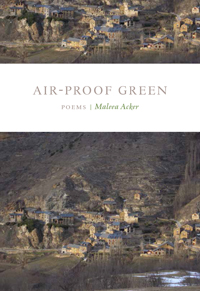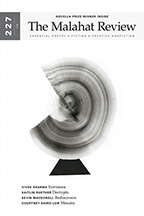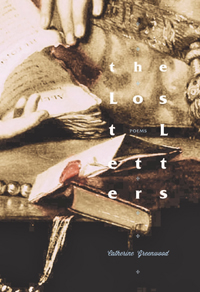Reviews
Poetry Reviews by Allison LaSorda
Catherine Greenwood, The Lost Letters (London: Brick, 2013). 85 pp., $20.00
Maleea Acker, Air-Proof Green (St. John’s: Pedlar, 2013). 86 pp., $20.00Catherine Greenwood’s The Lost Letters centres on the tale of Heloise and Abelard, a scandalous twelfth-century love affair. Through the realm of this impossible love story, the poet recalls the tension between physical and spiritual intimacy—a continually relevant theme—in romantic poems that rely upon accessible contemporary language. Greenwood deftly manipulates the centuries of emotion and, at times, the historical projection of romance on these figures. This idea is grounded by involving what likely goes unnoticed in their story: distinctly human oddities in the form of images, and unformed (read: intriguingly edited) fragments of notes throughout the third section of the collection. These numbered fragments are some of Greenwood’s most memorable pieces; they are effectively unique, and their imagery jarring and direct: “pouring hard / and tears / silverfish streaming from the mouldering stacks / important pages / devoured and destroyed.”
Maleea Acker, too, in Air-Proof Green,  moves the reader through the intersections of natural and human worlds. Her collection focuses on an intimacy with what is (un)knowable, and the more abstract unfolding of thought and sense. She demonstrates this theme elegantly in “A Slant View”: “When attention does not find itself / wanting to know, / to complete, the world abandons it / (and the viewer) to idleness. / Never the whole, only / part.”
moves the reader through the intersections of natural and human worlds. Her collection focuses on an intimacy with what is (un)knowable, and the more abstract unfolding of thought and sense. She demonstrates this theme elegantly in “A Slant View”: “When attention does not find itself / wanting to know, / to complete, the world abandons it / (and the viewer) to idleness. / Never the whole, only / part.”
The second section of The Lost Letters, entitled Turtle Soup, holds poems based on different species of animals, from Canadian-grown bushtits and a mule deer to more exotic lizards and elephants. “Two Blue Elephants” features standout opening lines that invited rereading: “Two elephants: blue as sky absorbed / in bodies of water, sorrow the marrow / of their spongy bones. Vessels of grief / so ancient they merely grin, blink salt / sweated through centuries of drought.” Though poignant, I found myself struggling to find a place or context for these poems amidst the focus on the untold elements of a historical romance.
By contrast, Acker’s poems feel completely rooted in the natural world, where romance is largely relegated to a realm of subjective perception. Interestingly, poems that examine animals more specifically come back to native Canadian species, both domestic (“Maisie the Dog”) and wild (“Salamander”) and are accompanied by landmark northern locations, like “Georgian Bay” and “Blue Mountain Lake Elegy”: “A green wall / divides my life. Birds, / fishes, foliage— / things disappear. / I can no longer get through. / Sometimes, remembering / is a thirst; I go out on the lake— / when I dip my hand / the losses return.” Air-Proof Green delivers a section of poems set in Farrera Catalunya, Spain, where meaning is strived for: “I’m savage too in another language, / untethered, charmed only by beauty or Latinate name / … he’ll be as I understand him, he’ll be / very little in the end.” Here, Acker uses foreign language as a metaphor for failing to sufficiently express or assign significance to what is experienced.
In a similar philosophical realm, somewhat outside of Heloise and Abelard territory, Greenwood’s poem “Yes and No” asks surprising, interesting questions. The nature of these inquiries is, I feel, reflective of the work as a whole, and serves to tie the diverse sections of the collection together. The speaker is “moving” or transforming “from a grey area of faith / to an open concept space / constructed solely of questions.” These questions are about physical life (recalling the second section of poems): “Would the animal shelter / find a home for your / ancient one-eyed tabby?”; about metaphysics (as in the third section of poems): “Did God the Father / like a heavenly sea horse cradling comets / in the pipe bowl of his belly … actually birth his own son?”; and abstract emotions (as in love, which is woven throughout, but is especially prominent in the final section): “Do you still love me (assuming / you once did)?”
Like Greenwood, Acker invokes elements of the traditional—eclogues, variations, and elegies—alongside an interest in various philosophies of perception. In particular, Air-Proof Green draws upon several epigraphs from the writings of Maurice Merleau-Ponty, who examined the role that perception plays into understanding, and argued that the body, rather than consciousness, is the primary site of knowing the world. This idea certainly bolsters Acker’s poems, where “between each roar / of the jackal bird / the world unfurls,” and the speakers of her poems explore, travel, and reflect on places and experiences as they are immediately perceived by the body; they express seemingly misplaced emotions, as in “The Aquarium”: “Measuring up, or measuring out over the quarter mile, finding / there is nothing the swallows haven’t already invented in / scrawling glide and suicide curve around the balconies,” exhibits envy of what is observed and may be deemed unattainable or, more likely, incomprehensible.
Catherine Greenwood and Maleea Acker have intrigued me in their use of natural imagery and in their daring gestures to phenomenology; each collection allows the reader to consider the threshold connecting instinct and reason, and how our search for meaning fits in to an unshakably complex natural world.
—Allison LaSorda










